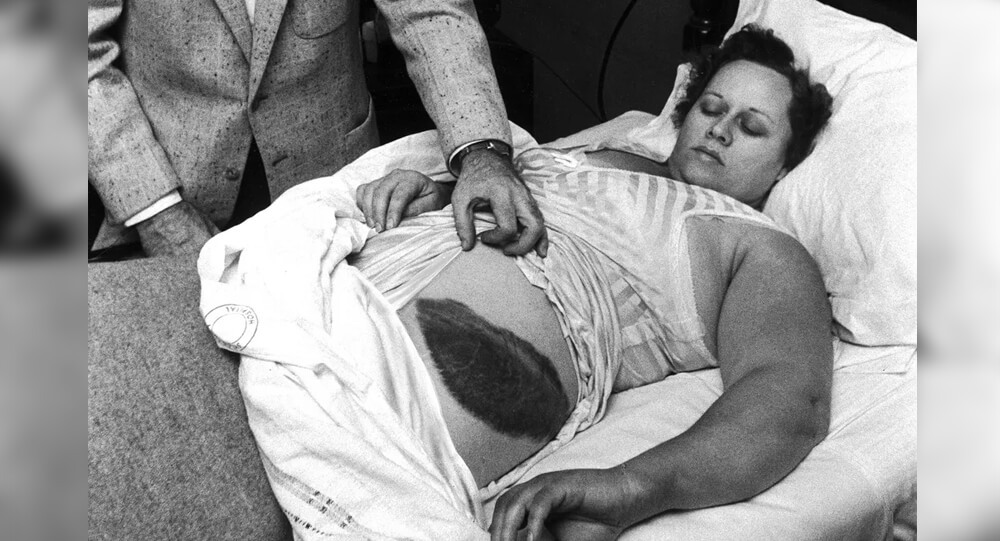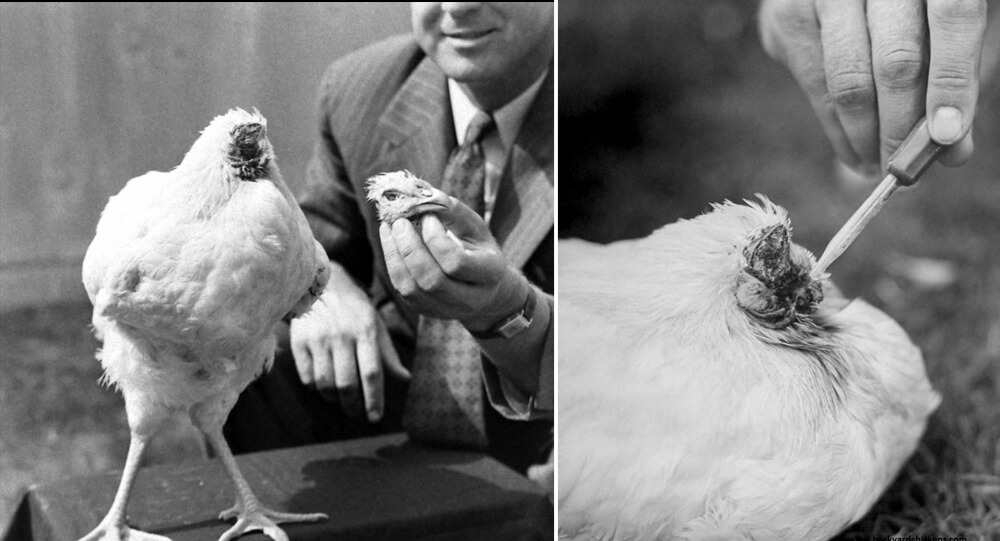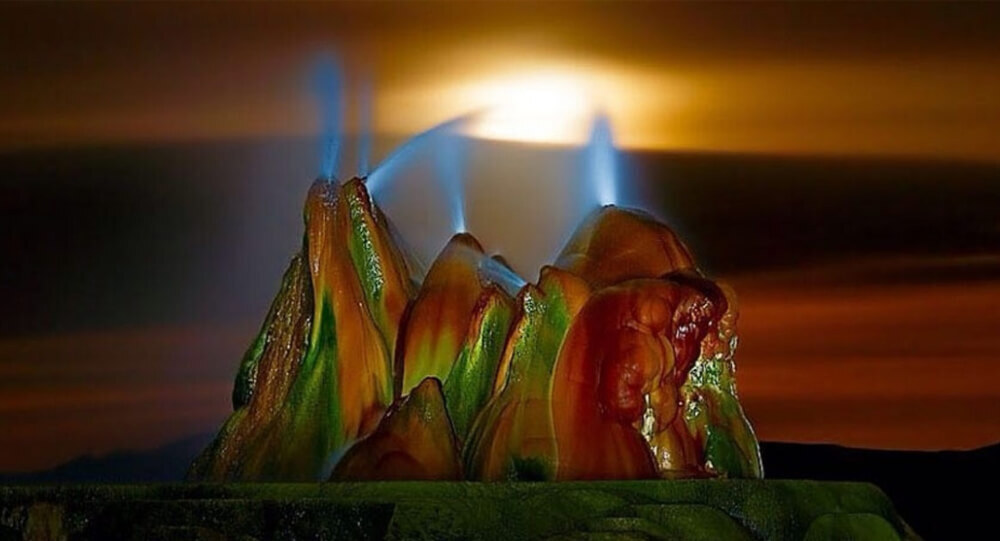
Visitors have been fascinated by the mesmerizing Fly Geyser in Nevada due to its vivid colors and otherworldly appearance. However, nature alone did not create this geological marvel. The formation of the Fly Geyser is an amazing result of both natural and human factors. The origins and evolution of Fly Geyser are examined in this article, along with the geological forces at work, human involvement, the significance of thermal energy, environmental impact, its transformation into a well-liked tourist destination, scientific discoveries, and difficulties associated with maintaining this remarkable site. Come along on a fascinating journey as we explore the mysteries of Nevada’s Fly Geyser.
The Discovery of Fly Geyser and Unusual Appearance
Nevada’s Fly Geyser is a mesmerizing natural wonder that seems to have emerged from a dream. In the 1960s, it was unintentionally produced when a geothermal drilling operation went wrong. The geyser, which has vibrant hues of red, green, and orange, resembles a gigantic, otherworldly fly, as its name implies, and is a truly captivating sight for everyone who visits.
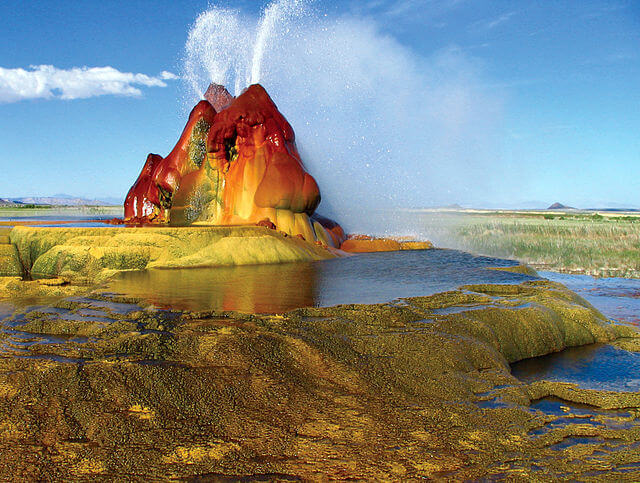
At a proud height of about 5 feet, the Fly Geyser continuously ejects steam and water into the atmosphere. Its ethereal and surreal appearance distinguishes it from other geysers. The geyser has been sculpted over time by minerals and thermophilic algae, giving it a distinctive shape and vivid colors. Its terraces are formed by the build-up of dissolved minerals, creating an otherworldly landscape that feels straight out of a science fiction movie.
Factors Contributing to the Formation of a Fly Geyser
The formation of Fly Geyser is significantly influenced by geothermal activity. The location is on top of a geothermal reservoir, where hot water and steam rise to the surface from deep within the Earth. The dissolved minerals that are gathered by this water as it flows through the underground channels are later deposited on the surface, helping to create distinctive structures like the geyser.
The Fly Geyser area’s distinctive features are greatly influenced by the region’s geological makeup. The area is primarily made up of a mixture of porous and fractured rock formations. The porous nature of these fractured rocks allows for the accumulation of minerals, giving rise to the vivid colors and terraced structures that give Fly Geyser its mesmerizing visual appeal. These fractures create pathways for geothermal water to reach the surface.
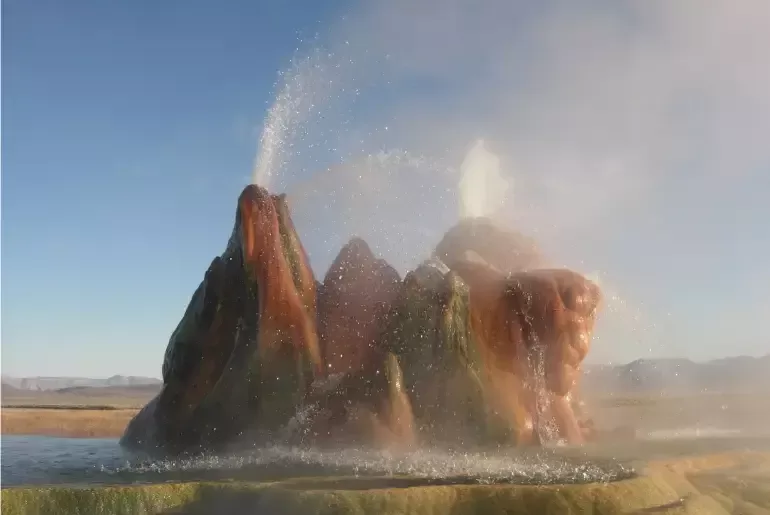
Human Intervention and the Formation of the Fly Geyser
In the 1960s, human intervention marked the beginning of the creation of Fly Geyser. A geothermal energy company unintentionally hit a geothermal pocket deeper than anticipated while drilling a geothermal well. The geyser and its distinctive terraces were first formed as a result of an uncontrolled release of geothermally heated water and dissolved minerals.
Drilling was essential in starting the construction of Fly Geyser. The delicate underground balance was upset by the drilling, which allowed the geothermally heated water to rise to the surface. As the water erupted, it carried dissolved minerals with it. As these minerals accumulated and solidified over time, they further shaped the geyser’s appearance.
Thermal Energy’s Role in the Growth of Fly Geysers
The growth of Fly Geyser is primarily driven by thermal energy. Groundwater is warmed by geothermal heat from deep within the Earth, which creates pressure that forces water and steam to the surface. These hot fluids interact with the minerals in the rocks as they ascend, causing the minerals to dissolve and be carried away. The dissolved minerals precipitate as the water cools and rises to the surface, which aids in the development of the distinctive formations at Fly Geyser.
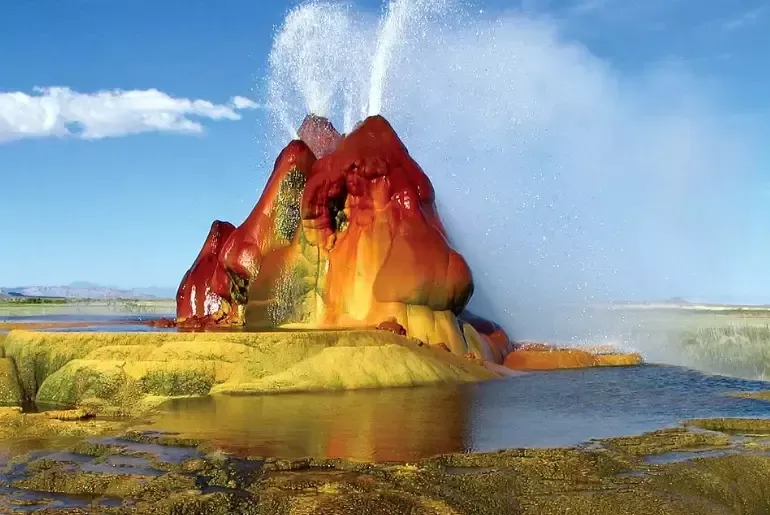
The underground reservoirs that store water that has been heated by geothermal processes are closely connected to Fly Geyser. The continuous activity of the geyser is fueled by these reservoirs. The mesmerizing display of water and steam is produced when heated water under pressure rises through cracks in the Earth’s crust, capturing the attention of tourists for decades. The constant flow sustains the growth of Fly Geyser, ensuring its unique existence in the Nevada desert.
Environmental Impact and Conservation Efforts in the vicinity of the Fly Geyser
Environmental Impact and ConservationLike a celebrity who attracts paparazzi, Nevada’s Fly Geyser is now a popular destination for tourists. But this vibrant geothermal wonder attracts more than just humans. Much to Mother Nature’s delight, the special environmental circumstances close to Fly Geyser have produced a thriving ecosystem.
Wetland vegetation and grasses have grown in the area as a result of the geyser’s ongoing eruptions and the presence of thermal water. They serve as a habitat for a variety of insects, birds, and small mammals that have adapted to living here. It resembles a bustling city for small animals, complete with hot tubs!
The management of Fly Geyser recognizes that with great fame comes great responsibility and values the preservation of this natural wonder. The distinctive geological features have been protected, and the delicate ecosystem balance has been preserved.
To protect the delicate formations, steps have been taken like limiting access to the geyser itself. To prevent overly eager feet from performing any unintended stunts, visitors can view the geyser from designated viewing areas. To encourage responsible tourism practices and respect for the delicate ecosystem, educational programs and awareness campaigns have also been launched.
These conservation efforts help guarantee that Fly Geyser continues to enthrall future generations, just as sunscreen protects our skin from harmful rays.
Scientific Research and Discoveries Inspired by the Fly Geyser
The Fly Geyser’s boiling water contains a vast microscopic universe that is just waiting to be discovered. Microorganisms that have evolved to survive in environments with high mineral concentrations and extreme heat have been found by researchers who have delved into this enigmatic realm. These tough creatures reveal hidden information about the possibility of life in hostile environments outside of Earth.
Who knows, perhaps these tiny survivors will impart some wisdom on adaptability and resilience to us. The microbes of Fly Geyser may one day teach us important lessons that will allow us to enjoy lattes on Mars.
In addition to its importance for biology, Fly Geyser contributes to the advancement of geothermal research. The location serves as a natural laboratory, providing researchers with important information about the potential of geothermal energy and the workings of the Earth.
Understanding the geothermal activity in the area of Fly Geyser not only enables us to harness clean, renewable energy, but also provides essential information for reducing the environmental impact of geothermal activity. One eruption at a time, science and sustainability are coming together.

Story of Peng Shuilin: Man with only half a body
We have a habit of whining in our daily lives. We never seem to be pleased with the things we have in life. "I want to be skinny," fat people say, "I want to be fat," slim people say. Poor people aspire to be wealthy, and wealthy people are never satisfied with their status. Everywhere we go, we're whining. Can you image how a man would want to live if he didn't have any legs or bums at all?

The Incredible Story of Martin Laurello, The Sideshow Performer With The Revolving Head
Martin Laurello was also known as 'The human owl'. He was born with the ability to turn his head a full 180 degree.

How a Man Fooled Florida with Fake Penguin Tracks for 10 Years
In 1948, Florida’s Clearwater Beach was the stage for one of the longest-running and most peculiar hoaxes in American folklore. Giant three-toed footprints appeared mysteriously in the sand, sparking rumor and fascination about a 15-foot-tall penguin roaming the shores. For a decade, locals and visitors alike speculated and scanned for the elusive creature, never realizing the truth: these tracks were made by a man wearing 30-pound lead shoes designed to imitate an enormous penguin's footprint. This article uncovers the details of this elaborate prank and its lasting legacy in Florida’s cryptic history.

[solved] “macaroni mystery”, 500 pounds of pasta dumped in new jersey
In April 2023, Old Bridge, New Jersey, faced a peculiar 'Macaroni Mystery' when 500 pounds of pasta were mysteriously dumped in the woods.

Why This Belgian Bar Makes You Trade Your Shoe for a Beer
To prevent tourists from stealing their beer glasses, some bars in Belgium require people to hand over one of their shoes as a deposit which is then put in a basket and hung from the ceiling. These shoe baskets have also become an attraction.

the world from someone predicting 2000 from a guy in 1910
Villemard, a French artist, illustrated how he imagined the future would be in the year 2000 in 1910.

The Heartbreaking Story Of Ella Harper, The ‘Camel Girl’
Ella Harper, Professionally known as the “Camel Girl” was born with a rare orthopedic condition that cased her knee to bend backward. Due to this condition, had to walked on all four legs, which resulted in her nickname as “Camel Girl”. Tough it was hard at first, but soon she made a fortune out of it.

Pierre Brassau: The chimpanzee painter who deceived the avant-garde world
Abstract paintings by a previously unknown artist “Pierre Brassau” were exhibited at a gallery in Sweden, earning praise for his “powerful brushstrokes” and the “delicacy of a ballet dancer”. None knew that Pierre Brassau was actually a 4 year old chimp from the local zoo.

Roller Coasters were First Invented to Distract People from sin
Roller coasters were invented to distract Americans from sin. In the 1880s, hosiery businessman LaMarcus Thompson didn’t like that Americans were going to places like saloons and brothels and created the first roller coaster on Coney Island to persuade them to go there instead.

The story of a boy who claims to be on Mars: Boriska Kipriyanovich
Boriska Kipriyanovich, who lives in Volgograd, Russia, claims he lived on Mars before being resurrected on Earth on a mission to redeem humanity. What we know about him is as follows:

In 2018, a 30-year-old survived a close-range gunshot thanks to silicone implant
In 2018, a 30-year-old woman from Toronto, Canada survived a close-range gunshot thanks to her silicone breast implant. Doctors believe that the implant deflected the bullet away from her vital organs, and her only injury was a fractured rib.

In 1954, an Extraterrestrial Bruiser Shocked This Alabama Woman.
In the year 1954, a grapefruit sized meteorite crashed through the roof of a farm house in Alabama, bounced off a large wooden console radio and hit Ann Hodges while she was napping on her couch. This was the first confirmed case of a person to be hit by a meteorite.

Belgian Woman Banned from Zoo After 4-Year Affair with Chimpanzee
A Belgian woman was banned from the zoo after having an affair with a chimp.

Preserving Bodies in a Deep Freeze Await Revival
There are currently hundreds of deceased people in the U.S., including baseball legend Ted Williams, whose bodies are frozen in liquid nitrogen in hopes that future technology will be able to revive them.

A man who has been suffering from headaches for nearly six months discovers chopsticks lodged in his brain
When it was discovered that a Vietnamese man with headaches and vision problems had chopsticks lodged in his brain, the doctors were almost as surprised as the man himself.

The Story of the Hidden Flight Simulator Game in Microsoft Excel 97
Before smartphones ruled hidden gaming, Microsoft slipped an extraordinary secret into one of its flagship office programs: a fully functional flight simulator game inside Excel 97. This little-known Easter egg captivated users who discovered a way to pilot a plane through the grid-like interface. Explore how this unexpected feature was created, the tech magic behind it, and why it remains a legendary piece of software lore.

In Pakistan, this banyan tree has been arrested since 1898
In Pakistan, a tree has been arrested and chained since 1898. When a British officer who was drunk assumed it was leaving its place, it was arrested. The tree, which is presently located on the grounds of the Pakistan Army's Landi Kotal cantonment, continues to attract visitors and locals everywhere.

Domestic Flight Delay Caused by Live Snake on Board Leaves Passengers in Shock
A domestic flight was unexpectedly delayed for nearly two hours after a snake was discovered slithering inside the plane’s cargo hold. Thanks to the swift efforts of a professional snake catcher and airline staff, the reptile was safely removed without any harm to passengers, turning a potentially alarming situation into a story of caution and calm.

Brazilian Man with Rare ‘Upside Down’ Condition Becomes Successful Accountant and Speaker
Born in Brazil with the rare and debilitating condition congenital arthrogryposis, which caused his head to be positioned upside down, this man was once written off by doctors who urged his mother to let him starve. Defying grim predictions, he overcame immense challenges to become a successful accountant and a powerful international motivational speaker, inspiring millions worldwide.

This Thai Wedding Tradition Happens 40 Feet Underwater
Each year in Trang, Thailand, dozens of couples participate in an underwater wedding ceremony while scuba diving in full gear. The ritual symbolizes deep love and has become a quirky tourist attraction held around Valentine’s Day.

The story of The chicken that lived for 18 months without a head
Mike the Headless Chicken was a rooster whose head was accidentally chopped off but miraculously survived. This is due to most of the brain stem being left intact. He was fed using a special tube that delivered food directly into his esophagus. Despite his lack of a head, he lived for 18 months, gaining worldwide fame before ultimately choking on a kernel of corn during one of his tours, in a Motel in Fruita, Colorado.

This Yogi Spent 76 Years Without Eating or Drinking Anything and Confirmed by
Prahlad Jani, the starving monk who lived 76 Years without food and water.

Vakil Batirshin’s Story: How Radiation Exposure Caused Severe Lymph Node Swelling
This is Vakil Batirshin, a man whose severe swelling from enlarged lymph nodes was reportedly caused by radioactive exposure. His condition highlights the devastating and long-term health effects radiation can inflict on the human body—often surfacing years after initial contact. Cases like his underscore the importance of nuclear safety and medical support.

Lucy and Maria The Biracial Twin Sisters with Rare Black and White Skin Colours
Lucy and Maria Aylmer are twins, but they have a hard time to convincing people. Even though they have mixed-raced parents, their mom was still shocked when the midwife handed her babies she’d expected to look alike, but were complete opposite.

Poland's Krzywy: The Mysteries of the Crooked trees
In Poland, there is a forest with 400 crooked trees that have a 90-degree bend at the base of their trunks. Despite of numerous possibilities, the real reason and how it evolved remain a mystery.




![[solved] “macaroni mystery”, 500 pounds of pasta dumped in new jersey](https://weeklyrecess.com/wp-content/uploads/2024/05/Macaroni-Mystery-cover.jpg)






